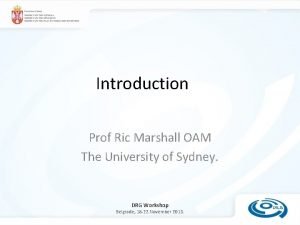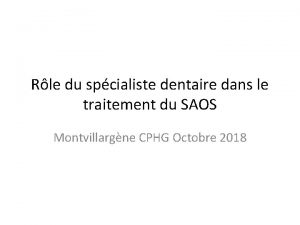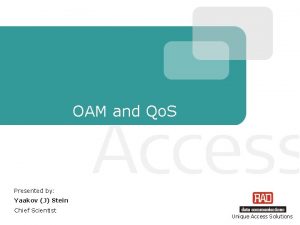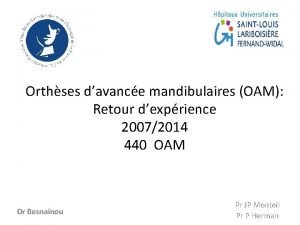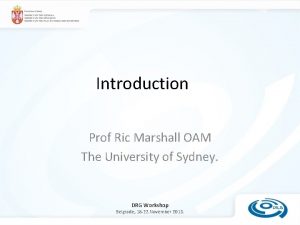Introduction Prof Ric Marshall OAM The University of







- Slides: 7

Introduction Prof Ric Marshall OAM The University of Sydney. DRG Workshop Belgrade, 18 -22. November 2013.

What is clinical coding? Clinical coding enables the translation of diagnoses, interventions and other health problems from words into alpha numeric codes, which permits easy storage, retrieval and analysis of the data. Source: The Australian Coding Standards, Seventh Edition, National Centre for Classification in Health, The University of Sydney, Commonwealth Department of Health DRG Workshop Belgrade, 18 -22. November 2013.

ICD-10 -AM and ACHI • ICD-10 -AM is the ‘International Statistical Classification of Diseases and Related Health Problems’, ‘Tenth Revision’, ‘Australian Modification. • ACHI is the ‘Australian Classification of Health Interventions’. DRG Workshop Belgrade, 18 -22. November 2013.

Where are ICD-10 - AM and ACHI codes used? Coding is a statutory requirement for certain health services. • Coding is assigned for every separation from a licensed bed in AUS hospitals; this includes day procedures and day rehabilitation. • Coding is assigned for any event where there is an admission to hospital. This is termed an ‘episode’. • Coding occurs in both public and private hospital inpatient settings. Importantly, these codes are NOT used when services are rendered… • By general practitioners within their practices • By outpatient clinics • In a community health setting • By community allied health professionals • In specialist rooms • By community pharmacy These services rely on MBS and PBS coding. DRG Workshop Belgrade, 18 -22. November 2013.

Why are the codes used? The codes are some of the most valuable health data elements. They can be used for many purposes, including: – – – Epidemiological studies of disease Trends Predictive modeling / forecasting Clinical research Health services / interventions evaluation Health services planning and design Quality assurance activities Reimbursement by health insurers for service provided to private patients Casemix management Utilisation review Activity-based funding DRG Workshop Belgrade, 18 -22. November 2013.

ICD-10 -AM code structures Definitions Examples • Chapter – is either a system of the body, special group chapters such as a type of disease • Block of categories – 3 character categories of common characteristics such as a physical site or condition. • Subcategories - Fourth and fifth digits that add specificity Chapter 19: Injury, poisoning, and certain other consequences of external causes – S 32 Fracture of lumbar spine and pelvis • S 32. 0 Fracture of Lumbar vertebrae – S 32. 03 Fracture of lumbar vertebrae. L 3 level Chapter 2: Neoplasms (C 00 -D 48) DRG Workshop – C 18 Malignant neoplasm of colon Belgrade, 18 -22. November 2013. • C 18. 6 Descending colon

So then…what is a DRG? Definition • • Example Diagnosis-related groups (DRGs) are a classification scheme which provides a clinically and statistically meaningful way of relating the types of cases treated in a hospital to the resources required by a hospital. The Australian Refined Diagnosis Related Group (AR DRG) is derived from a range of data collected on admitted patients, including diagnosis and procedure information, classified using ICD-10 -AM and ACHI. DRGs are not allocated manually because of the complexity involved. Specially designed software that assigns a DRG is called ‘grouper’ software. • ADRG G 60 Digestive malignancy DRG Workshop – DRG G 60 A Digestive Malignancy w/ catastrophic or severe complications – DRG G 60 B Digestive malignancy W/o catastrophic or severe CC • C 18. 6 bowel cancer Belgrade, 18 -22. November 2013.
